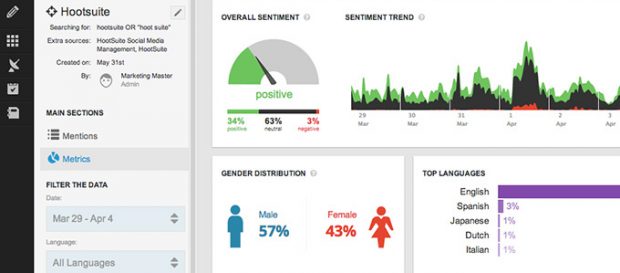How do you measure social? If you’re a social media marketer, it’s pretty much guaranteed that your boss has asked you to provide results showcasing your efforts. You might have initially been baffled as to how you would measure values such as awareness, what your customers think of your brand, or how your efforts are impacting the bottom line, but thankfully this is where KPIs, or “key performance indicators,” come to the rescue. In recognizing valuable KPIs, you are able to track not only your successes, but campaigns that perhaps missed the mark.
Key Social Media KPIs to Track
In monitoring and measuring your KPIs, you are able to focus your attention and efforts in order to optimize all of your resources to those most valuable to your organization. However, it can be difficult to know where to start when wanting to zero in on your social media measurement strategy, so to help you know what to look for, we’ve rounded up a list of suggested KPIs you can tailor to suit your business goals.
Social Media Presence
The first area you want to examine and measure is your brand or organization’s social media presence. How prominently does your company appear on social? How many people are talking about your organization, product, or service? These questions can all be answered by taking a look at the following KPIs.
1. Followers and fans
These are the easily measurable numbers of social media users who have subscribed to your account so they can see your content on their feed. Instagram and Twitter see followers, where Facebook business pages will have fans.
2. Number of mentions
A mention is “the act of tagging another user’s handle or account name in a social media message.” In measuring the number of mentions your brand is getting on social media, you are able to not only monitor conversations surrounding your company, but get a good indication of your company’s overall reach.
3. Reach
As our 2015 Social Media Glossary explains, “Reach is a data metric that determines the potential size of audience any given message could reach. It does not mean that that entire audience will see your social media post, but rather tells you the maximum amount of people your post could potentially reach. Reach is determined by a fairly complex calculation, that includes number of followers, shares, and impressions as well as net follower increase over time. Reach should not be confused with Impressions or Engagement.”
4. Inbound links
This is in reference to the number of links back to your blog or website you are getting from quality references. As Vital explains, “Link building should be a cornerstone of your SEO strategy. When someone links to your website it means you’re building your street cred within your given industry.” Hubspot echoes these sentiments, explaining that marketers must “keep track of your average inbound links so you can keep tabs on the quality of your content (more important than ever in the eyes of Google) and thus, your inbound links’ impact on your search authority.”
5. Blog subscribers
As a key component of your content marketing strategy that goes hand in hand with your social media efforts, your brand’s blog offers a great way to track overall success. As Hubspot describes, “There’s a direct correlation between the number of email subscribers you have and the amount of email traffic you generate to your blog. If you haven’t put a lot of effort into generating email subscribers, you’re sitting on a gold mine of opportunity.”
Social Media Engagement
While numbers reflecting your social media presence are valuable, knowing how engaged your audience actually is usually says a lot more about the success of your social media campaign. The following KPIs offer insight into your engagement levels and will also reveal areas where you could possibly improve.
6. Retweets
Retweets are “your Tweets forwarded by people who follow you to their own network of followers. This gives you the opportunity to reach more people who may think your content is valuable. That new network of Twitter users who are exposed to your Tweets have the potential to become a part of your primary network if they come back and follow you.”
7. Social shares
Like retweets, shares “take your content to the next level by spreading it across networks that you are not directly connected to. This allows you to increase social media engagement and brand awareness.”
8. Comments
While pretty self-explanatory, comments are messages and feedback left by other users, and a great way of tracking your audience’s general sentiment and feedback.
9. Referral traffic
Measuring referral traffic is a way of monitoring the amount of traffic going to your website or blog from your social media channels.
Social Media Reach and Influence
If a social media post doesn’t get a single like, does it still exist? Your message could be the most beautifully crafted piece of content on the face of the planet, but if nobody’s there to witness or engage with it, you are missing out on great opportunities for growth and reach. The following important KPIs will help you measure these areas, and ensure that your content doesn’t go unnoticed.
10. Share of voice
Share of voice is a metric for understanding how many social media mentions a particular brand is receiving in relation to its competition. Usually measured as a percentage of total mentions within an industry or among a defined group of competitors.”
11. Net promoter
As our 2015 Social Media Glossary explains, “A customer loyalty metric that is based on the following question: “On a scale of zero to 10, how likely is it that you would recommend our company, product, or service to a friend or colleague?” People who respond with a nine or 10 are designated as “promoters”; a seven or eight as “passives”; and a six or lower as “detractors”. The percentage of customers that are detractors is then subtracted from the percentage that are promoters to arrive at the company’s NPS.”
12. Sentiment
“An attempt to understand how an audience feels about a brand, company, or product based on data collected from social media. It typically involves the use of natural language processing or another computational method to identify the attitude contained in a social media message. Different analytics platforms classify sentiment in a variety of ways; for example, some use ‘polar’ classification (positive or negative sentiment), while others sort messages by emotion or tone (Contentment/Gratitude, Fear/Uneasiness, etc).”
13. Number of social influencers
With a social media influencer being “a user who can reach a significant audience and drive awareness about a trend, topic, company, or product,” the number of influencers your brand has working with you is a good indicator of popularity and overall success. If people want to work with you and represent your product or service, there’s a good chance you’re doing something right.
14. Post reach
This is the number of users who see a specific social media post.
15. Potential reach
As defined by Facebook, potential reach is those who “match the audience you defined through your audience targeting selections.”
16. Video views
Thanks to the inherent qualities in many video hosting platforms, video views are an easy-to-measure KPI and usually can be seen and monitored by anyone. However, as Rocky Walls at Convince and Convert explains, “If you have a CTA in your video and its purpose extends past a viewer simply watching the video, then judging the successfulness of the video should involve more than simply checking the number of views you have.”
Action and ROI
Once your content is out there, it’s important to measure whether your social media efforts are resulting in your desired outcomes. What are the actions you want your audience to complete, upon seeing your message? What are your business goals and objectives? While having users see your message in the first place is half the battle, it’s imperative that you’re seeing tangible results from your strategy. These KPIs offer ways to measure whether your messages are making their mark.
17. Conversions
As our Social Media Glossary defines, “In social media marketing, a conversion is a positive action that is taken on a website by a visitor from social media. The action demonstrates that the visitor is “converting” into a customer. Sales aren’t the only type of conversion; many websites measure webinar registrations, newsletter signups, content downloads, and other important outcomes that ultimately lead to a sale. Tracking conversions is crucial to properly attributing revenue to social media.”
18. Sales revenue
It’s probably safe to say that one of your business objectives is to increase revenue, and it goes without saying that sales revenue is the way to measure this. It’s important to know how your social media efforts are affecting your bottom line, and sales revenue is a way to pinpoint this. Dylan Kissane at Doz suggests, “When you close a sale, find out how the customer found out about you: a TV commercial, a Facebook interaction, word of mouth, or some other way.”
19. Issues resolved
If one of your business objectives is to improve customer service through social media, a great way to measure the progress here is through the number of issues your organization resolves. As Visually explains, “More people are turning to social media channels for issue resolution than ever before. In fact, 72 percent of customers expect complaints made on Twitter to be answered in an hour. Collect data on how people come to you for help or troubleshooting to make sure the busiest channels are monitored and staffed appropriately.”
20. Cost per lead
With your business depending heavily on leads, it’s important to know how much each one is costing you. Klipfolio provides a thorough definition of the term, explaining that “the purpose of this metric is to provide your marketing team with a tangible dollar figure so they understand how much money is appropriate to spend on acquiring new leads.”
21. Lead conversion rate
Once your business has the leads, the natural focus is to turn these leads into actual customers. The lead conversion rate measures the number of leads who actually convert to executing the action you desired of them. Kissmetrics offers a great guide to optimal lead conversion , including the easiest way to track this metric in Google Analytics.
22. Customer lifetime value
Earning the trust and loyalty of customers can be one of the trickiest things for an organization to conquer. It also seems like perhaps one of the more difficult KPIs to measure. However, it’s important when evaluating your business to have a general idea of the revenue a customer will generate for your business in their lifetime. , Kissmetrics has an article that explains how to do calculate your customer lifetime value (CLV) in the simplest way possible.
Internal KPIs
While it may be tempting to concentrate on the KPIs determined by your customers and audience, your organization’s internal measurement tactics are just as important. Recognizing the output of your employees and business overall makes it easier to leverage your resources and keep track of where time and energy is being devoted. In having an overall perspective of what your content team is producing, you have a much better chance of streamlining the process and offering your audience both quality and consistency.
23. Blog posts
If a blog is a part of your content strategy, take a look at how many blog posts you or your team is producing per week. It’s important to take into account how many hours go into the creation of a single blog post, and how many of these your brand is posting per week. What are the returns being seen on each blog post? Consider all of these factors when determining whether your team is concentrating on the most effective strategies.
24. Videos
With video the social media trend to watch in 2016, and with “the number of video posts per person increasing 75 percent globally and 94 percent in the U.S,” it’s a smart idea to dedicate time and resources to making video a top priority in your social media strategy. However, the creation and editing of video can easily become a timely endeavor, so it’s especially important to track how many hours your team is dedicating to this. How many videos are you sharing through your social media channels per day? Is the ROI worth it?
25. Social media posts
The number of social media posts your brand is posting per day is probably one of your key internal KPIs. You want to keep this consistent so that you remain top of mind for your audience, but you definitely don’t want to overwhelm them with a barrage of constant posts. Finding the best number of posts for your organization may take some trial and error, but through keeping track of what works, and what doesn’t, you will quickly find a number that works for you.
26. Social media budget
This is probably one of the KPIs most important to your manager. You will obviously want to set goals and keep a close eye on how much budget you are setting aside for social media. If you find that you are spending more than you or your boss would like, our blog post on how to decrease your social media budget can provide some guidance.









